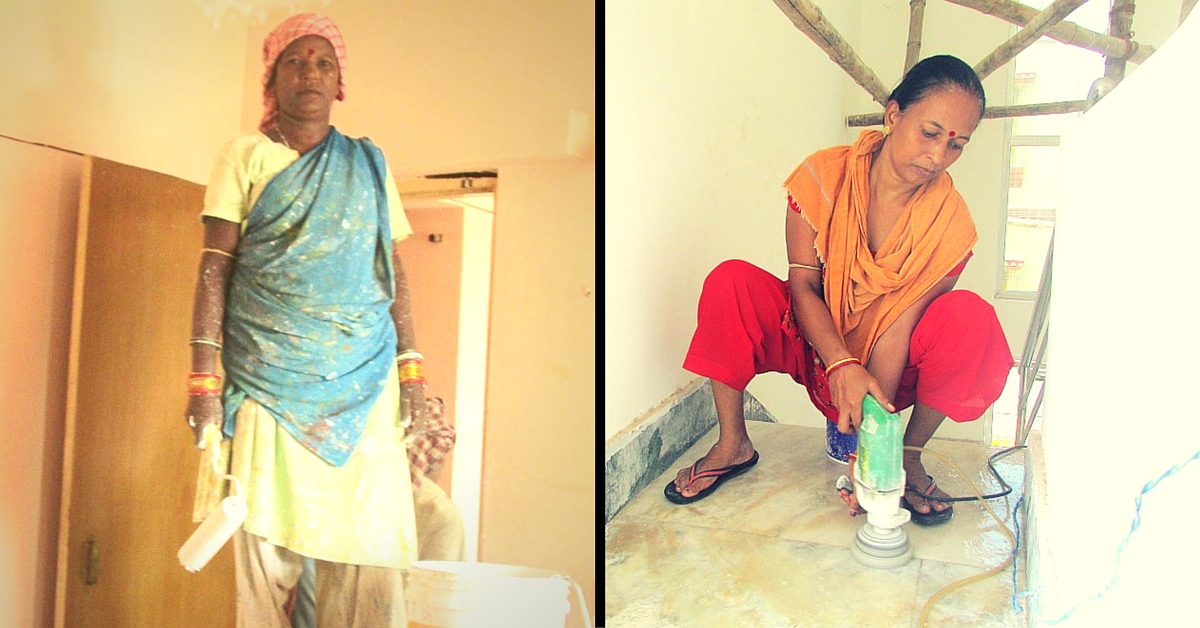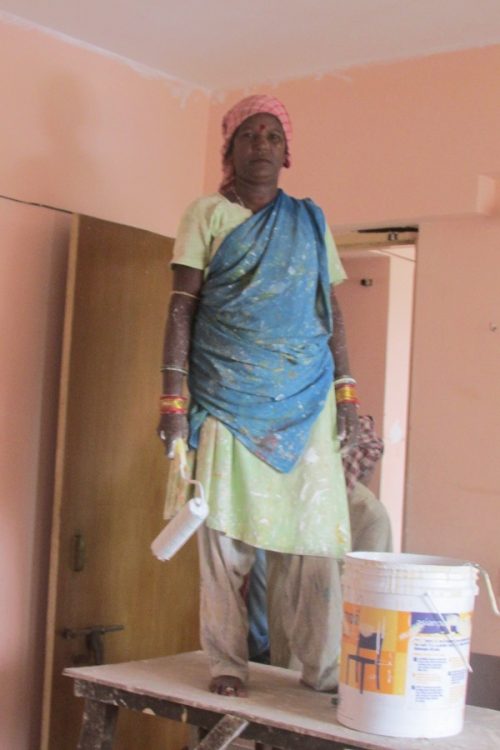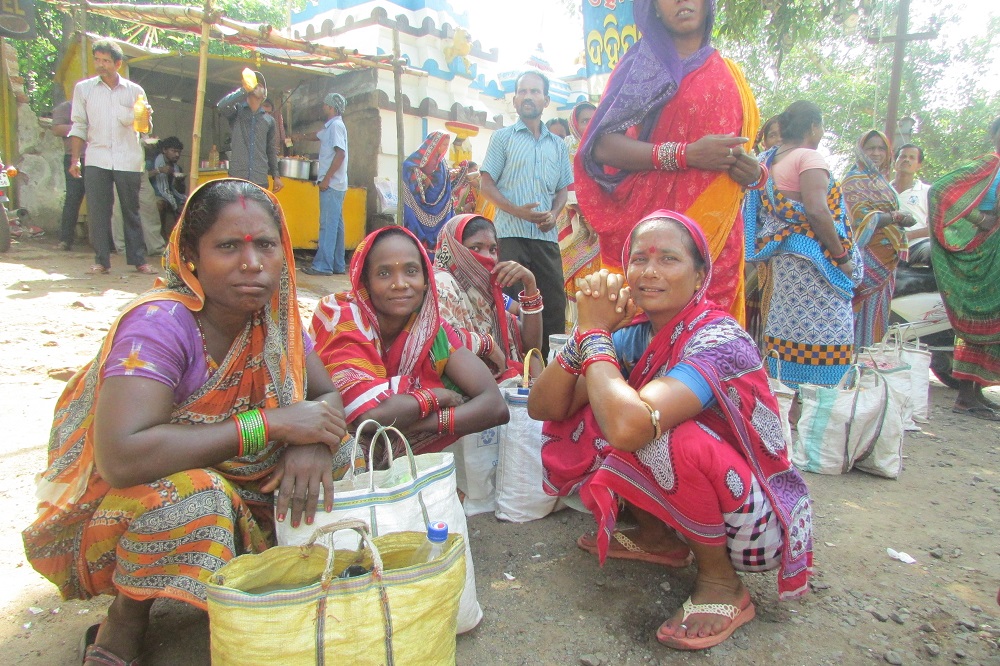Meet Two Women Who Call the Shots at Work, in the Male-Dominated Construction Business
Strong-willed women in Odisha are slowly changing the structure of workforce in the construction sector, which is usually seen as a male-dominated area.

Strong-willed women in Odisha are slowly changing the structure of workforce in the construction sector, which is usually seen as a male-dominated area.
Generally, when one pictures a construction site, it’s a space where men are in-charge – as contractors, supervisors, masons, painters, and so on. Women are relegated to the role of being the overworked, underpaid unskilled labourers. But while this may be the overwhelming reality, when women do get the opportunity to skill themselves not only do they outshine their male counterparts but are, in fact, able to secure plum assignments without the assistance of middlemen that otherwise control this sector.
In her crowded slum of Salia Sahi in Bhubaneswar, Odisha, Radharani, 43, is a respected community member. The neighbourhood women look up to her because, unlike her lot, she calls the shots at home and in her workplace.

As a highly skilled painter she has carved her own place in the local construction business, where everyone respects her for her workmanship and professionalism. Heading a team of five women, whom she has trained, she is conscious of delivering quality work on time.
Obviously, when Radharani had decided to venture into this line of work things were not all that easy – initially, she encountered stiff resistance from contractors and, later on, people were either surprised to see a woman in action or expressed their doubts in her abilities.
She recalls, “Six years back, I had got a contract for painting a state-run guest house. I was hard at work one morning perched on my bamboo ladder when the engineer in-charge called out to me. When I came down and took off my headscarf he was astonished to see me and remarked that he had never imagined that he would be seeing a woman head a team of painters.”
Radharani has learnt the work from her husband, Shankar Pradhan, who decided to rope her in because they needed to bring in more money to pay for the education of their two children.

Radharani remarks, “My husband taught me how to paint but now I can do better work than him. I get more assignments and make more money. However, he doesn’t mind it and even tries to pitch in with the housework.”
Like Radharani, Sabita Sathua, 45, has distinguished herself as a marble mason although there are times when she ends up being at odds with her male counterparts from her own state as well as those coming in from neighbouring Bihar and West Bengal.

“In this line, women are not accepted as stone masons. The mindset is that they can only work as labourers. I have proved them wrong by doing better work,” she remarks with immense pride.
Hers is a story of struggle both on the personal and the work front. Abandoned by her husband, Sabita had to work day-and-night to support herself and her only son. Starting out as a daily wage labourer to make ends meet she had to learn on the job and even fend off unwanted advances. She realised soon enough that if she wanted to augment her earnings she would have to upgrade her skills. “I had noticed that the stone masons made good money and so I set my sights on becoming one. But when I approached some masons to take me through the process they were hesitant. Who had ever heard of a woman stepping into a man’s domain? Yet, I managed to convince them. I was desperate to ensure that my son got a good education. He is in college these days.”
It’s been over 15 years and Sabita’s stature as a marble mason has only grown. “I work with an all-male team. There are times when we have disagreements but they know I am in charge. As such men do have a tendency to exploit and harass a woman but I have realised it’s entirely up to a woman as to how she wants to deal with the situation. I have always held a strong ground so people eventually fall in line.” As masons their earnings are not set because they depend on the contracts they get but generally they make around Rs 400 a day. “The best part is that by word of mouth I get steady work. People approach me directly which is a good thing,” says Radharani.
Indeed, both Sabita and Radharani have shown that a determined attitude and familial support can go a long way for women to succeed in this sector. Unfortunately, they are still a minority.

Apart from a lack of training avenues, social restrictions and regressive mindsets conspire to keep women down. What’s truly disturbing is the level of exploitation they have to encounter – unequal pay, punishing hours, poor working conditions and the threat of sexual harassment are a part and parcel of their everyday existence.
Among other regions in the state, significant migration takes place from Tangi block in Khurda district. Largely belonging to the fisher community, which is increasingly finding itself out of work due to a decline in fish production in the Chilika Lake, families move en masse in search of viable livelihood. Every year, more than 5,000 people from the area seek work at construction sites in and around Bhubaneswar. Commuting daily from the fringes of the city to the labour ‘nakas’ (markets) around the state capital they wait for contractors to hire them. Naturally, they have no bargaining powers when it comes to negotiating for wages or other benefits. The women are especially disadvantaged. Anima Behara, a construction worker, states, “The contractor pays better wages to men. They think women cannot work as hard as men; that we only support them.” Adds Sumati Behara, “There’s nothing worse than being a female construction worker. From the crack of dawn we are labouring away – we rush to finish household chores as we have to commute a long way to get to the ‘nakas’. We toil all day on site, for what? A pittance. Women do so much and even then everyone thinks we don’t deserve to be paid at par with the men.”
The lived realities of women like Anima and Sumati may be rough at present but things may change for the better. Odisha has enacted The Building and Other Construction Workers (Regulation of Employment and Conditions of Service) Act 1996, which guarantees as many as 20 social security provisions to construction workers.
To ensure that this workforce has access to benefits, which include assistance for education and marriage, maternity benefit and a stipend to those undergoing skill development training, among others, the State Labour Department has started to register names for issuing identity cards.

Nearly 14,24,531 construction workers have been registered till March 31, 2016. “Since women may not be able to take out time to come to the Labour Office to enrol them from work sites, we have decided to strengthen our mechanism and expand our manpower,” says Subhas Singh, Chairperson, Odisha Building and Other Construction Workers Welfare Board. Moreover, the Odisha State Social Security Board is planning to issue Unorganized Workers Identification Number (UWIN) cards.
Roopa Mishra, Labour Commissioner is optimistic about the future of construction workers. She talks of the state government’s MoU with six RPL (Recognition of Prior Learning) training partners for the skills upgradation of both men and women workers. “So far, 47,000 workers have benefitted from this training. We are planning to provide Rs. 200 as training fee so that the daily wage workers can attend the programme without any hassle,” she shares.
As skilled workers, Radharani and Sabita are not just conscious team leaders – “we understand the needs of our colleagues” – they are better pay masters – “we give everyone equal wages” – as well. Clearly then, skills upgradation and proper implementation of the Act are keys to empowering women workers.
Like this story? Have something to share? Email: [email protected], or join us on Facebook and Twitter (@thebetterindia). To get positive news on WhatsApp, just send ‘Start’ to 090 2900 3600 via WhatsApp.
This story made me
-
97
-
121
-
89
-
167
Tell Us More
We bring stories straight from the heart of India, to inspire millions and create a wave of impact. Our positive movement is growing bigger everyday, and we would love for you to join it.
Please contribute whatever you can, every little penny helps our team in bringing you more stories that support dreams and spread hope.



















